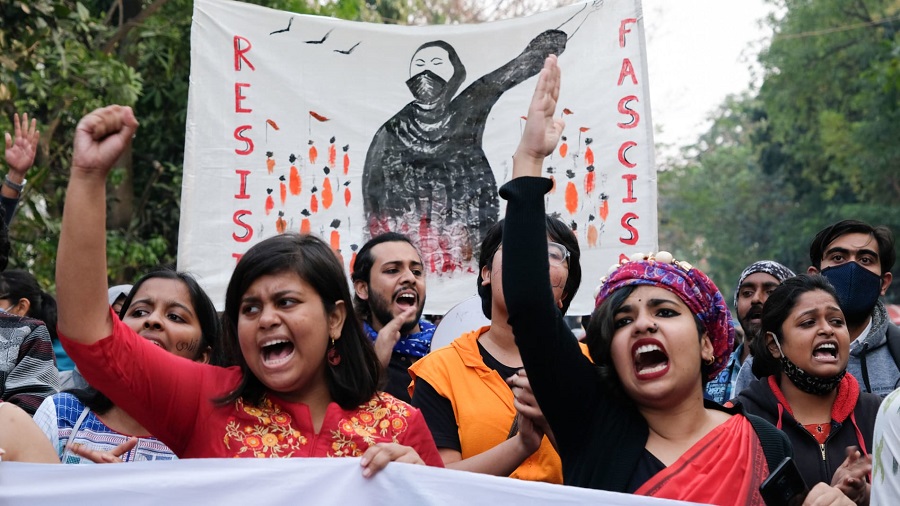
In a video that has since gone viral on social media, a group of men gather on a dusty street in India's southern Karnataka state.
Carrying saffron-colored flags and matching scarves, the men chant loudly in unison as they taunt their targets: Muslim women in hijabs who remain huddled in one corner of the street.
The visual confrontation between their black and blue Islamic garments and the raging sea of saffron -- a color closely associated with Hinduism -- is symbolic of deepening divisions in the country caused, in part, by the rise of Hindu nationalism.
What started in January as a peaceful demonstration by six Muslim students protesting for the right to wear hijabs in their state-run school has morphed into a larger movement defined by gender, religion and clothing. And the arrival, weeks later, of counter demonstrators clad in saffron is indicative of the blurring lines between the Indian state and religion.
The orange-yellow hue, seen as a symbol of divinity in Hinduism, has been brazenly adopted by the far-right Hindutva movement and, in recent years, increasingly politicized. The movement seeks to homogenize Indian culture around Hindu values.
For India's Muslims, meanwhile, the hijab has become a symbol of resistance against the wave of Islamophobia spreading across the country, as women wearing the religious garment protest in various towns and cities in support of the students.
"I started covering my head three years ago as a protest against crimes against Muslims," said 23-year-old Muslim activist Afreen Fatima in a phone interview. She had been demonstrating in her hometown of Allahabad in northern Uttar Pradesh state.
"But now, it has become a spiritual obligation for me. It's an assertion of my identity. I am an Indian Muslim and I'm not going anywhere."
A symbol of resistance
The hijab, an Islamic headscarf, is worn by millions of Muslim women around the world as a sign of modesty and privacy. But in some countries the garment has proven controversial, with critics depicting it as a symbol of oppression or arguing that it is incompatible with secular values.
In 2004 the French government banned religious garments, including the hijab, in state schools. Seven years later France became the first country in Europe to ban all face-covering garments in public spaces, with policymakers describing the move a matter of national identity and security.
Other European countries have since followed suit with similar restrictions, though the types of veil permitted -- and where they can be worn -- differ.
In India, however, the hijab is neither banned nor restricted in public spaces, and the right to practice one's faith is guaranteed under the country's secular constitution. But, like elsewhere in the world, Muslim women can face backlash and discrimination for choosing to wear one.
According to Indian poet and activist Nabiya Khan, Muslim women are "imagined in an Islamic veil and seen as submissive" because they do not "fit the feminist narrative of the liberal elite."
"I wear (a) hijab because I want to," she said via WhatsApp. "It serves me a religious and spiritual significance. It brings me closer to my god."
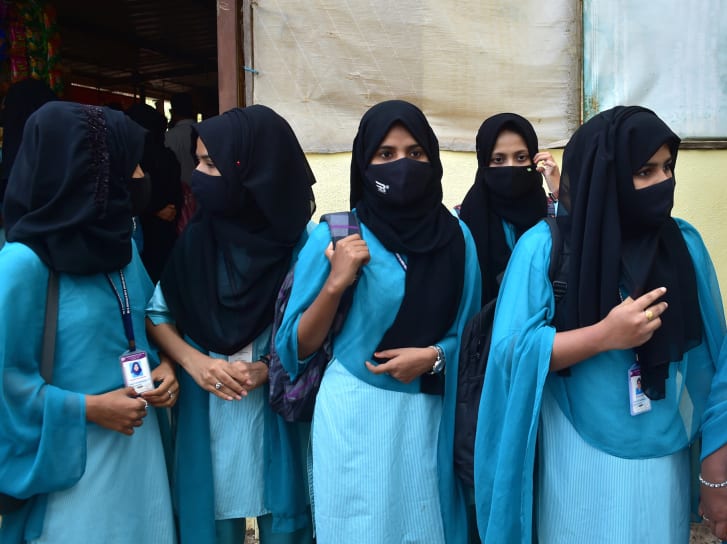
Muslim students leave their school in Udupi, Karnataka, after they were denied entry on February 16, 2022. Credit: Stringer/Anadolu Agency/Getty Images
The conflict in Karnataka began after a small group of hijabi students were denied entry to their classrooms in the coastal city of Udupi, according to the petition they later filed in the state's top court. In early January, the girls staged a protest outside their government-run school, demanding they be allowed inside. But their teachers refused.
Their demonstration prompted rival protests from right-wing Hindus carrying saffron scarves and flags (such as those captured in the aforementioned video), chanting a religious Hindu slogan in support of the ruling Bharatiya Janata Party (BJP) and demanding the girls remove their head coverings.
The clashes proliferated through Karnataka, with the state ordering a three-day closure of all high schools and colleges in early February. Authorities in the state's capital, Bengaluru, also banned protests outside schools for two weeks.
Karnataka's education minister B.C. Nagesh said he supported banning the hijab in educational institutions. Citing the state's mandate on religious attire, the CNN affiliate CNN News-18 that Karnataka's government "is very firm that the school is not a platform to practice dharma (religion)."
But activists say the hijab row runs deeper than a dress code, claiming it's just the latest in a wider crackdown on India's minority Muslim population since Prime Minister Narendra Modi's BJP came to power almost eight years ago.
The BJP did not respond to CNN's request for comment or to allegations that it advocates Hindu nationalism and is using the hijab row for political gain. When asked about the hijab controversy during a meeting with reporters in February, India's Finance Minister, Nirmala Sitharaman, told CNN the matter was for Karnataka's government to handle.
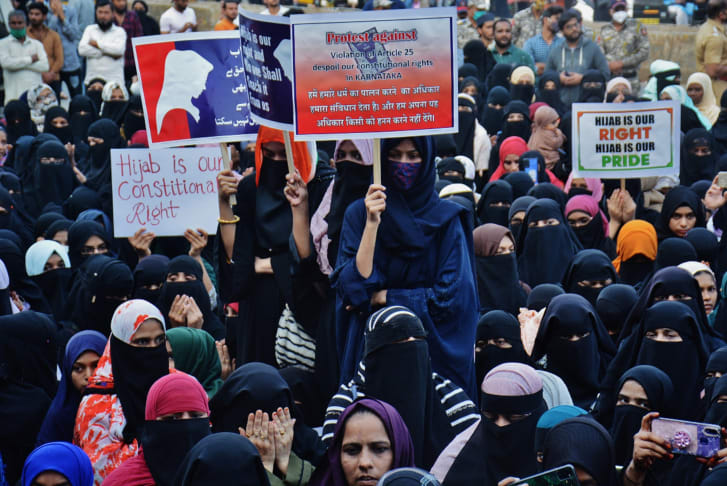
Muslim women in Mumbai protest against the Karnataka government on February 13, 2022. Credit: Praful Gangurde/Hindustan Times/Getty Images
Karnataka has already passed legislation that, critics say, is rooted in Hindutva ideology. Last year, the state banned the sale and slaughter of cows, an animal considered sacred to Hindus. It also introduced a controversial anti-conversion bill, which makes it harder for interfaith couples to marry or for people to convert to Islam or Christianity.
For Fatima, the hijab row is just the latest move from authorities to quell Muslim voices.
"This movement is us fighting for our faith, identity and religious freedom," she said. "By wearing our hijab and taking this stand, we are telling Hindus that we are not going to back down."
In one of the most striking scenes from the February stand-off, a hijab-wearing Muslim student, Muskan Khan, does exactly that. In another video, which also went viral, Khan is seen being accosted by men as she gets off her scooter to hand in a school assignment.
They heckle her, demanding she take off her hijab. But instead of complying, Khan shouts back "Allahu Akbar" -- meaning "God is great" in Arabic -- and punches her fist in the air.
Her raised fist has become an icon of defiance. In an act of solidarity, scores of Muslim women have changed their Twitter profile photos to a silhouette of Khan's raised fist, while her likeness has appeared on placards and posters at demonstrations.
Ashish Bagchi is one of many designers and artists who have shared illustrations inspired by Khan on social media. His image depicts her walking with her head held high as saffron-tinted arms -- representative of the Hindu right -- encroach on her.

Ashish Bagchi's illustration depicts saffron-tinted arms surrounding Muskan Khan, who has become a symbol of resistance against the proposed hijab ban. Credit: Ashish Bagchi
Bagchi's personal political works, which appear on his Instagram and Twitter, present a narrative of India's shrinking freedoms.
"What really moved me was the way she stood her ground," he said. "What stood out for me was those men shouting and brandishing her with their saffron stoles. Sadly, the saffron color now symbolizes a particular political ideology."
The politicization of color
The color saffron has roots in Hinduism -- one of the world's oldest religions -- and represents peace. About 80% of India's 1.3 billion people are Hindu, and the color is seen draped on idols in the temples, tied around the neck of cows and used as street decorations during festivals.
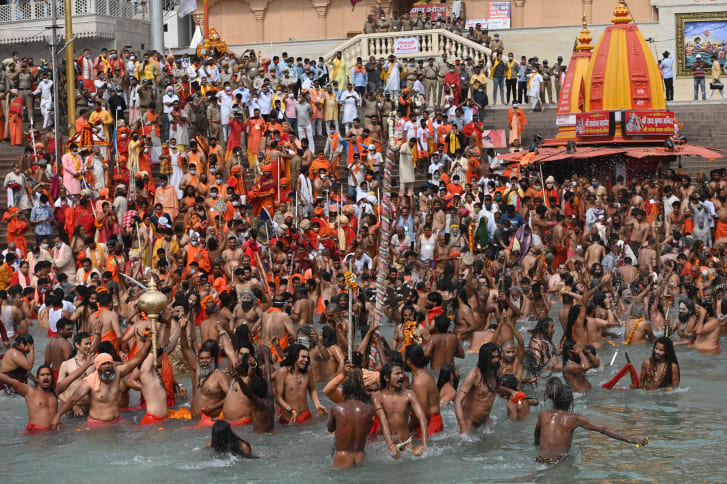
Hindu holy men take a dip in the Ganges River during the religious Kumbh Mela festival, in Haridwar on April 12, 2021. Credit: MONEY SHARMA/AFP/Getty Images
But ever since the BJP swept to power with a Hindu nationalist agenda in 2014, the color has become increasingly politicized. Modi and his compatriots are often seen donning saffron-hued clothing and accessories at election rallies, while supporters wave the party's flag (which is primarily saffron) or other similarly colored ones.
"The appropriation of saffron is a way of signaling that the party is not just political, but deeply rooted in religion," said Gilles Verniers, an assistant professor of political science at India's Ashoka University, in a phone interview.
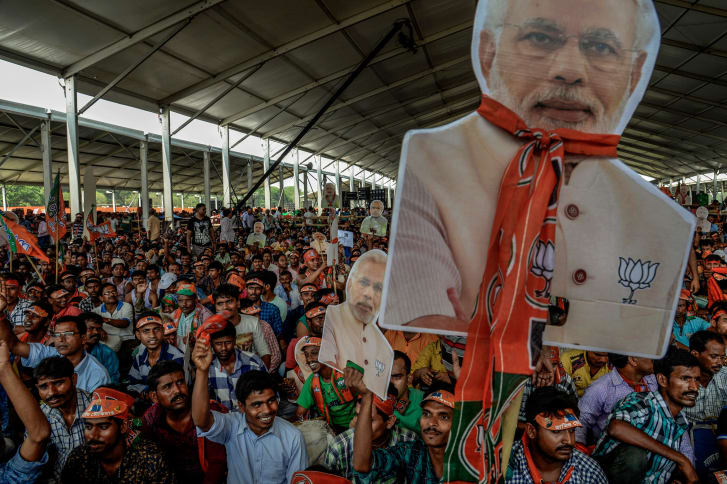
A crowd at a rally for Prime Minister Narendra Modi on April 3, 2019 in Kolkata, India. Credit: Atul Loke/Getty Images
"The color serves the purpose of a 'uniform' and gives BJP supporters a sense of unity and commonality."
The BJP's Yogi Adityanath, Chief Minister of India's most populous state, Uttar Pradesh, is one high-profile figure who is almost always seen dressed head-to-toe in the color. Arguably one of the most polarizing figures in Indian politics, Adityanath -- a former Hindu priest -- is known for his provocative rhetoric against Muslims.

Yogi Adityanath at the inauguration of the Awadh Shilpgram Cultural Centre and Marketplace in Lucknow, India, on March 19, 2021. Credit: T. Narayan/Bloomberg/Getty Images
And while not every Hindu that wears the color espouses Hindu nationalism, when politicians dressed in saffron make statements against the country's minorities, it emboldens far-right groups to do the same, according to historian Aditya Mukherjee.
"The religious symbolism used by the Hindu right today is a complete inversion of what Indian culture is. They have given the color a different meaning," said Mukherjee.
"This is not what the Hindu religion stands for. And it's certainly not an organic feeling coming from many Hindu Indians.
"It is a very scary moment for India," he added, referring to how extremists have carried out violent attacks against Muslims.
It is symbolic, perhaps, that as saffron becomes an increasingly common sight in public life, the hijab's status in India has now been thrown into question. Karnataka's High Court has finished deliberating over whether schools can ban headscarves or not, and a ruling is expected soon. In the meantime, its interim order to prohibit all religious clothing in educational institutes with an existing dress code or uniform, still stands.
For the activist Fatima, removing the hijab is "like asking our women to strip."
"It is fathomably disturbing. It is unethical," she said, adding that she will not be "silenced" by the growing Hindu right.
"The options we as Muslims have to demand justice are very few. Muslim women have it worse. We don't have the privilege to remain silent. We will assert our identity even more."











